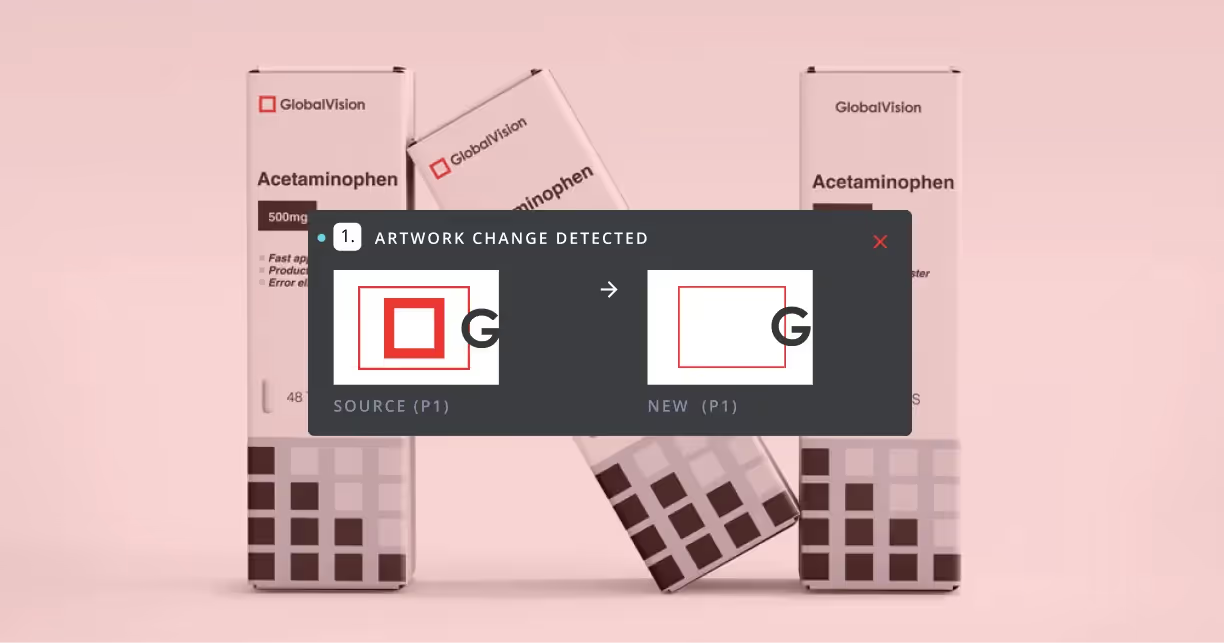That’s why artwork comparison has become an essential part of every labeling team’s
What Is Artwork Comparison?
Artwork comparison is the process of examining different versions of a packaging file to detect differences, whether visual, textual, or structural. It’s often used in packaging and labeling workflows to:
- Compare design revisions
- Confirm regulatory updates are properly implemented
- Catch text, graphic, barcode, and braille issues
- Ensure consistent branding and color use
Traditional methods relied heavily on manual inspection, which can be time-consuming and prone to human error. Now, teams are adopting automated artwork comparison software that rapidly highlights even the most minor deviations between files.
Why Artwork Comparison Is Critical in Labeling Workflows
Leading companies know that packaging artwork inspection is more than a design task, it’s a necessity for compliance. Here’s how artwork comparison tools play a vital role in high-stakes environments:
1. Prevents Regulatory Mistakes
A missing allergen warning. A dosage misprint. An outdated barcode.
In regulated sectors, small oversights can trigger major problems. Automated label artwork verification ensures that the latest regulatory changes are reflected correctly in all print files, reducing risk of non-compliance.
2. Saves Time on Proofing
Manual proofreading is slow and error-prone. Graphic proofing tools automate this process by instantly flagging changes between file versions, so reviewers can focus only on the differences that matter. This leads to faster approvals and fewer bottlenecks.
3. Supports Multilingual Accuracy
If your packaging includes multiple languages, you know how challenging it is to catch localization errors. Artwork comparison software can detect even subtle text changes across languages, improving the accuracy of translated content and supporting global compliance.
4. Reduces Costly Print Errors
Spotting a font change or misplaced logo after printing can result in tens of thousands of dollars in wasted materials. Print-ready artwork review tools help ensure that what you see on screen is exactly what will be printed, no surprises.
5. Improves Cross-Team Collaboration
From regulatory affairs to marketing to production, many stakeholders touch the artwork. Automated PDF artwork comparison tools make it easy for teams to share, comment on, and verify changes in one unified workflow.
Try the Labeling Error Cost Calculator
How much could a simple artwork error cost your team?
Use the calculator below to see how quickly costs add up from a single labeling mistake.
Inputs:
- Units affected (e.g. 10,000)
- Cost per unit (e.g. $0.75)
- Regulatory fine (if applicable) (e.g. $50,000)
- Reputation damage estimate (optional) (e.g. $20,000)
Calculation:
Total Cost = (Units affected × Cost per unit) + Regulatory fine + Reputation damage
Example Output:
A misprint on 10,000 units at $0.75 each, plus a $50,000 fine and $20,000 in reputation-related losses = $77,500 total cost
All from one missed artwork change!
As you can see, even a single oversight can quickly spiral into tens of thousands of dollars in lost product, regulatory penalties, and brand damage.
That’s where automated artwork comparison software comes in. By detecting even the smallest discrepancies between artwork versions, before files go to print, these tools act as a final line of defense in your labeling workflow.
From catching missing text in warnings and incorrect barcodes to flagging formatting issues and copy changes, automated comparison helps your team prevent errors from eating into your budget.
Key Features to Look for in Artwork Comparison Tools
Not all solutions are created equal. When evaluating artwork comparison or graphic proofing tools, look for features like:
- Pixel-perfect side-by-side and overlay comparison for detecting artwork, text, and formatting changes
- Smart layer detection that isolates differences in text, graphics, and layout, even across different file types
- Font Size Verification to ensure regulatory compliance and catch subtle sizing discrepancies often missed by manual checks
- Support for complex, high-resolution packaging formats including PDF, AI, and layered files
- Automated version control with full audit trails to meet regulatory and QA requirements
Seamless cloud integration with platforms like Veeva, Esko, Adobe Creative Cloud, and other content management systems
Real-World Example: How Automated Proofing Helps Labeling Teams
Packaging and labeling teams, especially in highly regulated industries like pharmaceuticals and cosmetics, face intense pressure to ensure every change is accurate and compliant. Even small errors in text-heavy labels, such as ingredient lists or safety warnings, can lead to costly reprints, regulatory issues, or brand damage.
Take Dempsey Corporation’s Beauty Division as a real-world example. Before adopting automated proofreading, their quality team relied heavily on manual reviews, with one person responsible for catching every error across dozens of label versions. Fatigue, version confusion, and missed errors were common, putting both speed and quality at risk.
By integrating automated comparison software into their label review process, Dempsey dramatically reduced human error, streamlined approvals, and increased overall productivity. In peak seasons. What used to take hours now takes minutes freeing up resources and ensuring that every label is accurate before it goes to print.
This shift where artwork comparison moves from a manual bottleneck to a scalable, automated checkpoint, is becoming standard practice across industries. For labeling teams, automated file comparison is no longer just a safeguard, it’s a core part of a compliant, efficient, and audit-ready workflow.
You can read the full Dempsey case study here.
Upgrade Your Artwork Labeling Processes
Your artwork labeling team can’t afford to let critical packaging errors slip through the cracks. Investing in automated artwork comparison software is more than just adopting new technology, it’s about safeguarding your brand reputation, protecting your customers, and securing your bottom line.
By leveraging reliable visual inspection and smart artwork comparison tools, your team can catch costly errors early, accelerate review cycles, and confidently prove compliance with ever-evolving regulatory standards. The result? Faster approvals, fewer costly reprints, and a smoother path to market.
FAQs




